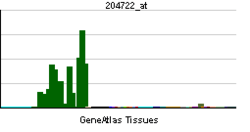SCN3B
| View/Edit Human | View/Edit Mouse |
Sodium channel subunit beta-3 is a protein that in humans is encoded by the SCN3B gene.[3][4] Two alternatively spliced variants, encoding the same protein, have been identified.
Function
Voltage-gated sodium channels are transmembrane glycoprotein complexes composed of a large alpha subunit and one or more regulatory beta subunits. They are responsible for the generation and propagation of action potentials in neurons and muscle. This gene encodes one member of the sodium channel beta subunit gene family, and influences the inactivation kinetics of the sodium channel.[4]
Clinical significance
Mutations in the gene are associated with abnormal cardiac electrophysiology.[5][6]
See also
References
- ↑ "Human PubMed Reference:".
- ↑ "Mouse PubMed Reference:".
- ↑ Morgan K, Stevens EB, Shah B, Cox PJ, Dixon AK, Lee K, Pinnock RD, Hughes J, Richardson PJ, Mizuguchi K, Jackson AP (Apr 2000). "β3: An additional auxiliary subunit of the voltage-sensitive sodium channel that modulates channel gating with distinct kinetics". Proc Natl Acad Sci U S A. 97 (5): 2308–13. doi:10.1073/pnas.030362197. PMC 15797
 . PMID 10688874.
. PMID 10688874. - 1 2 "Entrez Gene: SCN3B sodium channel, voltage-gated, type III, beta".
- ↑ Hakim P, Gurung IS, Pedersen TH, Thresher R, Brice N, Lawrence J, Grace AA, Huang CL (2008). "Scn3b knockout mice exhibit abnormal ventricular electrophysiological properties". Prog. Biophys. Mol. Biol. 98 (2-3): 251–66. doi:10.1016/j.pbiomolbio.2009.01.005. PMC 2764399
 . PMID 19351516.
. PMID 19351516. - ↑ Hakim P, Brice N, Thresher R, Lawrence J, Zhang Y, Jackson AP, Grace AA, Huang CL (January 2010). "Scn3b knockout mice exhibit abnormal sino-atrial and cardiac conduction properties". Acta Physiol (Oxf). 198 (1): 47–59. doi:10.1111/j.1748-1716.2009.02048.x. PMID 19796257.
Further reading
- Hirosawa M, Nagase T, Ishikawa K, et al. (2000). "Characterization of cDNA clones selected by the GeneMark analysis from size-fractionated cDNA libraries from human brain". DNA Res. 6 (5): 329–36. doi:10.1093/dnares/6.5.329. PMID 10574461.
- Hartley JL, Temple GF, Brasch MA (2001). "DNA Cloning Using In Vitro Site-Specific Recombination". Genome Res. 10 (11): 1788–95. doi:10.1101/gr.143000. PMC 310948
 . PMID 11076863.
. PMID 11076863. - Stevens EB, Cox PJ, Shah BS, et al. (2001). "Tissue distribution and functional expression of the human voltage-gated sodium channel beta3 subunit". Pflugers Arch. 441 (4): 481–8. doi:10.1007/s004240000449. PMID 11212211.
- Wiemann S, Weil B, Wellenreuther R, et al. (2001). "Toward a Catalog of Human Genes and Proteins: Sequencing and Analysis of 500 Novel Complete Protein Coding Human cDNAs". Genome Res. 11 (3): 422–35. doi:10.1101/gr.GR1547R. PMC 311072
 . PMID 11230166.
. PMID 11230166. - Simpson JC, Wellenreuther R, Poustka A, et al. (2001). "Systematic subcellular localization of novel proteins identified by large-scale cDNA sequencing". EMBO Rep. 1 (3): 287–92. doi:10.1093/embo-reports/kvd058. PMC 1083732
 . PMID 11256614.
. PMID 11256614. - Ratcliffe CF, Westenbroek RE, Curtis R, Catterall WA (2001). "Sodium channel β1 and β3 subunits associate with neurofascin through their extracellular immunoglobulin-like domain". J. Cell Biol. 154 (2): 427–34. doi:10.1083/jcb.200102086. PMC 2150779
 . PMID 11470829.
. PMID 11470829. - Meadows LS, Chen YH, Powell AJ, et al. (2002). "Functional modulation of human brain Nav1.3 sodium channels, expressed in mammalian cells, by auxiliary beta 1, beta 2 and beta 3 subunits". Neuroscience. 114 (3): 745–53. doi:10.1016/S0306-4522(02)00242-7. PMID 12220575.
- Strausberg RL, Feingold EA, Grouse LH, et al. (2003). "Generation and initial analysis of more than 15,000 full-length human and mouse cDNA sequences". Proc. Natl. Acad. Sci. U.S.A. 99 (26): 16899–903. doi:10.1073/pnas.242603899. PMC 139241
 . PMID 12477932.
. PMID 12477932. - Ota T, Suzuki Y, Nishikawa T, et al. (2004). "Complete sequencing and characterization of 21,243 full-length human cDNAs". Nat. Genet. 36 (1): 40–5. doi:10.1038/ng1285. PMID 14702039.
- Casula MA, Facer P, Powell AJ, et al. (2004). "Expression of the sodium channel beta3 subunit in injured human sensory neurons". NeuroReport. 15 (10): 1629–32. doi:10.1097/01.wnr.0000134927.02776.ae. PMID 15232296.
- Adachi K, Toyota M, Sasaki Y, et al. (2004). "Identification of SCN3B as a novel p53-inducible proapoptotic gene". Oncogene. 23 (47): 7791–8. doi:10.1038/sj.onc.1208067. PMID 15334053.
- Suzuki Y, Yamashita R, Shirota M, et al. (2004). "Sequence Comparison of Human and Mouse Genes Reveals a Homologous Block Structure in the Promoter Regions". Genome Res. 14 (9): 1711–8. doi:10.1101/gr.2435604. PMC 515316
 . PMID 15342556.
. PMID 15342556. - Gerhard DS, Wagner L, Feingold EA, et al. (2004). "The Status, Quality, and Expansion of the NIH Full-Length cDNA Project: The Mammalian Gene Collection (MGC)". Genome Res. 14 (10B): 2121–7. doi:10.1101/gr.2596504. PMC 528928
 . PMID 15489334.
. PMID 15489334. - Wiemann S, Arlt D, Huber W, et al. (2004). "From ORFeome to Biology: A Functional Genomics Pipeline". Genome Res. 14 (10B): 2136–44. doi:10.1101/gr.2576704. PMC 528930
 . PMID 15489336.
. PMID 15489336. - Kimura K, Wakamatsu A, Suzuki Y, et al. (2006). "Diversification of transcriptional modulation: Large-scale identification and characterization of putative alternative promoters of human genes". Genome Res. 16 (1): 55–65. doi:10.1101/gr.4039406. PMC 1356129
 . PMID 16344560.
. PMID 16344560. - Mehrle A, Rosenfelder H, Schupp I, et al. (2006). "The LIFEdb database in 2006". Nucleic Acids Res. 34 (Database issue): D415–8. doi:10.1093/nar/gkj139. PMC 1347501
 . PMID 16381901.
. PMID 16381901. - Hakim P, Gurung IS, Pedersen TH, et al. (2008). "Scn3b knockout mice exhibit abnormal ventricular electrophysiological properties". Prog Biophys Mol Biol. 98 (2–3): 251–66. doi:10.1016/j.pbiomolbio.2009.01.005. PMC 2764399
 . PMID 19351516.
. PMID 19351516.
External links
- GeneReviews/NIH/NCBI/UW entry on Brugada syndrome
- SCNB3 protein, human at the US National Library of Medicine Medical Subject Headings (MeSH)
This article incorporates text from the United States National Library of Medicine, which is in the public domain.

